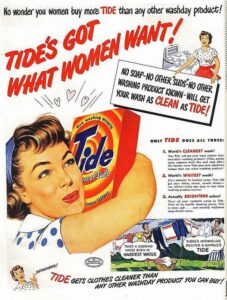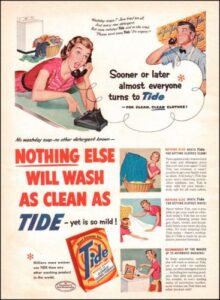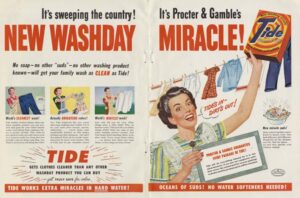
The average American ignores 3,500 ads daily.
That’s a lot. In fact, it’s so much you can say we ignore the shit out of advertisements every day. Are people immune to advertising manipulation?
It seems like even though we disregard ads on the conscious level, manipulation in advertising is still working in the subconscious. It’s not the old school, buy this product, type of ads anymore. Things are a bit more sophisticated.
However, I have a gut feeling that you already know that. You’re here to learn how to manipulate people to buy more of whatever you’re selling.
And yes, I said manipulate, not persuade. So what?
Manipulation in advertising. A brief history.
In order to understand how manipulation in advertising works, we have to go down history lane and explore how marketers marketed and what made it evolve to its current form.
Nobody reads ads. People read what interests them.
Howard Gossage
Sometimes it’s an ad.
First, let’s get out of the way that manipulation and marketing go hand in hand. Manipulation in advertising is everywhere.
Call it persuasion, influence, whatever-the-fuck-you-like. It’s all a form of manipulation. You are reading this article because you were manipulated.
In his book “Manipulation”, psychologist Josef Kirschner goes over a great example of how laundry detergent companies are manipulating us to buy their product.
Have you ever noticed how identical Tide, Arm & Hammer, or any other laundry detergent ads are like? Every time it’s the same housewife, using a generic brand detergent and a friend of theirs comes up, showing them what they’re missing out on for not using the more expensive stuff.
In the last twenty years, laundry detergent companies have expanded to soccer moms and chefs, but that’s neither here nor there as the messaging stays the same.
This type of advertising leverages a popular kind of manipulation. The kind that makes you feel like you’re missing out on something.
And they aren’t the only ones that do this. Take, for example, The Economist. They’ve been in business for 170 years. What’s arguably their most iconic ad reads:
Who gets the office copy first? Precisely.
The Economist
It has one of the greatest hook sentences ever, but it also uses the same manipulation technique to get you to buy The Economist. Who gets the office copy first? The boss.
To see the full scope of how The Economist has managed to stay relevant for almost two-hundred years, Cole Schafer over at HoneyCopy has an excellent article on the topic. You can read it here.
Now, you understand the basics of manipulation in advertising. Make the customer fear they’re missing out. What they’re missing out on? Quality, quantity, a great deal, the thing that can transform their life (okay, this is a bit farfetched). But it’s important to remember that…
People will buy for two reasons — it makes them feel good or it takes the pain away.
Reading The Economist makes you feel like you’re the boss. Advil takes the headache away. Ferrari’s make you feel like you’ve done something with your life.
If you take a closer look at how companies market their products, they usually fall under one of these two categories.
But to stay on the topic of manipulation in advertising, we have to dive deeper. Once you know why your customers are buying your product, you can influence them to buy yours.
It’s called brand perception. Brand perception is powerful. Brand perception is done through well thought out advertisement and a consistent narrative.
Some time ago, I wrote an article for Better Marketing, covering the topic of how FIAT resulted in selling a tiny car in a market dominated by trucks.
Spoiler alert, it’s brand perception. They used PPC to appear at the top of search results, manipulating people into thinking FIAT sells the best city car. Now, people didn’t even have to click. Seeing the FIAT brand on top of the search results was enough to help the company beat Toyota.
And mind you, FIAT hasn’t sold a single car for 30 years in America prior to launch.
I go pretty in-depth in the article. You can read it here. (Friend link, because we’re friends, no?)
To influence how people perceive your brand, you have to build marketing campaigns that carry the same messaging throughout.
Coca-Cola advertisements show happy people gulping ice-cold Coke in every ad. Coke is for the happy moments in life.
Advil ads tell you they take the pain away to do what you love. I think it’s clear what they leverage in their advertising.
Using manipulation in your marketing.
Okay, finally what you’re here for. The dark-side stuff, as a friend of mine, likes to call it. Even though they aren’t really dark side at all.
Before reading any further, you have to understand that any form of marketing you’ve ever done has some manipulation technique in it. Now you’ll just be doing stuff in a more understanding way. Here’s how you can implement manipulation in your advertising:
- You have to understand who your customer is.
More importantly, understand their pain points. Why they buy your product. - Target those pain points.
Companies of all sizes are missing this point. They are “too ethical” or “it’s below them” to use their customer’s pain points to sell their product. That’s a whole lotta bull. There’s nothing unethical if you do it correctly.
For example, Advil doesn’t sell a headache pill. They help you enjoy the time with your kids to the fullest. And their drug actually takes the pain away. The pain point is the time missed with your kids. - Sell them the dream.
Instead of showing what you do, show people what life becomes when they buy your product. Mercedes sell a pretty capable offroad truck, yet soccer moms are riding in G-wagons all throughout the US.
Mercedes don’t market how good the G class is. They market its premium features. Mercedes sells you the feeling that comes with owning a G-wagon. - Rinse and repeat.
You aren’t advertising to the same group of people over and over again. It’s more like a constantly moving crowd. Get your winning ads, re-do them, and reuse the concept until it’s tired.
Following the train of thought, people rarely buy something out of logic. Most decision making is peripheral, meaning, they will notice an ad, jump around the thought, and take the plunge to buy whatever they were advertised.
We, as marketers can use this weakness in the human mind to sell more of whatever we’re selling. But there’s a catch to it. It has to be done ethically. The products we’re advertising have to be good. Otherwise, it’s all a waste of time.
***
👋 Hey! I’d like to introduce Electric.
It’s my (still tiny) newsletter where I help marketers and creators, like you, grow with kick-ass marketing from around the world.
Want to help grow it? Come in.


